Review for Bamboo Blade: Series 1 - Part 1
Introduction
If there is one genre that is underrepresented in UK anime, it's sport. That constantly stymies me, given how much we love sport in this country. You'd think that connecting anime fans with sports fans wouldn't be too much of a stretch. We're not all isolated into our own little niches, you know? We can like more than one thing at a time. But of all the anime that we get in the UK, sports anime is a rarity. There's tournament anime aplenty, usually involving some ridiculous and long-winded series of battles for a hero to prevail in shows like Naruto, or Pokemon. We've had made-up sports like Angelic Layer, where participants used mind control to send their mini-robot best friends into gladiatorial combat. We do get the occasional futuristic racing anime, like Oban Star Racers or IGPX, but something contemporary, with codified rules and with a more realistic outlook… I can only think of Suzuka, a high school romance centred on an athletics team, and that wasn't even completed in the UK.
Yet the Japanese love their sports anime, and there are plenty of fans in the US willing to buy them, so dubbed versions aren't exactly scarce either, and there are stories for practically any sport you can imagine. Well, maybe not cricket, but there are countless anime about baseball like Big Windup and Princess Nine. American Football gets the Eyeshield 21 treatment. Basketball is catered for in Slam Dunk, you can guess what Prince of Tennis is about, Ashita no Joe and Hajime no Ippo for boxing. Even board games get anime shows, with Hikaru no Go and Shion no Ou getting all cerebral. I watched Saki on Crunchyroll last year, a show about Mah-jong. I understood nothing of what was going on, yet I enjoyed it terribly. This year had a golden opportunity for getting anime on television in the UK. A world cup year saw the release of an anime all about football called Giant Killing. Yet in the country that invented the game, I doubt more than a couple thousand people even know the show exists. Would you have minded if in between the matches, a TV channel had shown a cartoon about football? It would have just added to the party atmosphere, and maybe distracted from those damnable vuvuzelas! Fortunately for those in the know, it was and still is available on Crunchyroll. But that isn't exactly the same thing.
Manga Entertainment seek to address this dearth of sports anime in the UK, by releasing Bamboo Blade. It's true that Manga Entertainment owes a good portion of its fortune to blades in anime, swords most of all, after all just listening to the sound effects over their blood spattered logo is an indication of what butters their bread. And kendo is sword fighting, but with big blunt sticks instead of sharp metal. But this isn't about pain, bloodshed and violence, this is about teamwork, about bettering oneself, about rules and competition, about tournaments, about winning one for the Gipper. In other words, it's sport! And it's about time too!
Toraji 'Kojiro' Ishida is a layabout and loser teacher at Muroe Private High School, and it's usually his pay packet that he loses. He can barely afford to feed himself, and is reduced to scrounging off his students. He also half-heartedly coaches the school's kendo team after school hours, not made easier by the new school year meaning the departure of the old team, and the few remaining members intimidated by a couple of bullies who like waving big sticks around. But a night out with an old friend, and coach of a rival school's kendo team changes all that when he makes a bet. If his girls' kendo team can beat Ishibashi's kendo team, then he'll be able to eat for free for a year. Now all he needs is to recruit a girls' kendo team. The ideal recruit would be Tamaki Kawazoe, daughter of a kendo master who grew up in a kendo dojo, but she would rather watch anime instead.
This 2-disc collection presents the first half of Bamboo Blade, thirteen episodes in all as follows.
Disc 1
01. A Bamboo Broom and a Champion of Justice
02. The Blade Bravers and Boxed Lunch
03. Black and Blue
04. Pink and Blue
05. Muroe High and Machido High
06. Tamaki Kawazoe and the Tardy Bureiba
07. Sushi and Mince Meat Cutlets.
Disc 2
08. Tama and Part-time Work
09. Kojiro and the Crossroads of Fate
10. Miyako Miyazaki's Melancholy and the First Tournament
11. Animation and Dreams
12. Azuma's Circumstances and Mei's Circumstances
13. Teachers and Students
Picture
Bamboo Blade gets a 1.78:1 anamorphic widescreen transfer, which is the usual NTSC-PAL standards conversion, although it isn't particularly cursed with indications of such. The image is mostly clear, there is a deliberate haze and brightness to the animation that goes well with the light and entertaining tone of the show, and the colours follow a soft pastel palette that also reflects this. The character designs are simplistic, but distinctive, and the world design is similarly appealing. Where the show excels is in the animation, particularly of the kendo sequences, which have had a lot of effort and time spent on them to imbue them with style and energy. The show has a cute conceit of fading out the facemasks during the match sequences, allowing you to see the characters. All in all, Bamboo Blade is a very appealing animation, quirky yet familiar.
Sound
You have the usual options, DD 5.1 English and DD 2.0 Japanese, with optional translated subtitles or a signs only track. You won't be surprised to hear that I went with the Japanese audio, and was very happy with that. I really adore the cute voice that Tamaki gets in the Japanese audio, and that contrasts with my brief experience of the English dub, where they attempted to emulate that, but she winds up sounding like a frail old woman to my ears. The English dub has that perennial problem of older actresses trying to sound like teenaged girls, and it sounds more and more awkward as the years pass. But, the surround sound does have an impact when it comes to the matches and the kendo sequences, as well as bringing out the catchy theme songs.
Extras
The discs get static menus and jacket pictures. The only extras are on disc 2, and they are the usual textless credit sequences.
Conclusion
It turns out that Bamboo Blade isn't a pure sports anime, rather a slice of life anime with sports in, just as Suzuka was a romance with sports in. It certainly increases the interest level, as there is only so much Rocky style 'underdog does good' antics, typical of sports stories, that a person can take before it begins to weary. If all Bamboo Blade consisted of was girls hacking away at each other with sticks, then you'd probably be able to take about five or six episodes of that before tedium would set in. That said, there is certainly enough kendo in the anime to appeal to fans of the sport, and to get the layman clicking on a few websites to find out more. Also, the degree of effort that has gone into animating the kendo sequences makes watching it worthwhile. It isn't every animation that is thoughtful enough to consider stance, footwork, and style. But in between the kendo, the anime focuses on developing the characters and telling their stories, and it's here that Bamboo Blade excels, rich in warmth and humour that makes it a very appealing and rewarding show to watch. It's very good at what it does, and I have found it to be the unexpected highlight of the year so far.
It's the characters in Bamboo Blade that are so special, beginning with the motive force behind it all, the demotivated kendo instructor Toraji 'Kojiro' Ishida. Always hard up and looking for his next meal, the big moment in his life was when he defeated his friend Ishibashi at a kendo tournament, sparking a rivalry that has lasted ever since. He's a part time teacher at Muroe High School, and given a kendo club that is sparse in members, and not exactly glowing in results, he hardly puts an effort in. It's when that rivalry with Ishibashi is rekindled, as a bet is made where free food is the prize, that Kojiro comes to life with the kendo club, only to find that he has just two genuine members, and one of them absent. He may be suddenly enthusiastic about winning, but it's always with an ulterior motive, one that he doesn't even bother to mask.
Kirino Chiba is one of the members. She's enthusiastic and eager when it comes to kendo, and it's usually her who motivates her teacher, instead of the other way around. She would love to be part of a genuine kendo team, and her happy go lucky nature makes her the heart of what will eventually become the kendo club. Her friend Sayako Kuwahara is the absent one and she is the exact opposite, flighty, easily discouraged, and apt to follow the latest trend and the current fad. When we encounter her she's in her novelist phase, which is soon followed up by the guitar phase, but for some reason, which is usually wanting to beat Kirino, she keeps coming back to the kendo club. The thing is that there needs to be five members in a team, which leads to a bout of recruiting.
The ideal member would by Tamaki Kawazoe, daughter of a master of a kendo dojo; she's more skilled than anyone we encounter. The trouble is that she's far more interested in anime than kendo, and it takes a fair bit of convincing to get her to join. If Kirino is the heart, Tamaki is the soul of the team, flawless in her skills and inspiring awe in all who watch her or compete against her. She's also the cutest thing that you'll ever see, short for her age, soft spoken and almost terminally shy. As lethal and flamboyant as she is when in her kendo gear, she's absolutely self-effacing and reticent otherwise, and joining the kendo club is her first real chance to have friends her own age and come out her shell. She hardly breaks a sweat when it comes to kendo, but she's nervous and sweating the first time she tries a part time job where she will actually have to interact with the public.
Then there is Miyako Miyazaki, tall, elegant, sweet and charming. She joins the kendo club because her boyfriend joins, and she dotes on Danjuro Eiga completely. She's light and fluffy and all things nice… when he's around. Otherwise she can slip into a delinquent mode where if looks could kill, she'd be a mass murderer. This dark side appears on more than one occasion, and it turns out that kendo is a useful outlet for her delinquent side. It also turns out to be quite the hilarious reversal later in the series when we learn that there is someone who can equally strike fear in Miyako, simply through sheer, unmitigated devotion, as we meet her creepy stalker Reimi.
Although Kojiro is trying to build the ultimate girls' team, he winds up with two boys anyway. Yuuji Nakata knows Tamaki from her fathers' dojo, and enjoys kendo himself, although he doesn't get the attention in his kendo that the girls' team gets. He's more the comic relief at this point. You'd think that Danjuro would be the comic relief, he's certainly drawn that way, a mascot like form unlike any of the other characters, and the striking contrast between him and his girlfriend Miyako is material for countless double-takes (she rides a bicycle and has a little sidecar for Dan), but he turns out to be quite the driving force in the narrative, enthusiastically supporting his girlfriend, and rapidly improving at kendo himself.
The final member of the team, and not even fully recruited at the end of these episodes is Satori Azuma, a girl who is almost up to Tama's standards when it comes to the sport, but who has had to give up her passion because of her failing grades. While she's good at kendo, she's scatterbrained, and a little clumsy. She even wears fake glasses in the hope that they will make her smarter. We only catch glimpses of her in most of the episodes in this half, and she's the least developed of the cast.
Were this a pure sports anime, we would have lots of training, tournaments and practices all the way through the run, till the climax when we would get to see who would triumph in the bet, no doubt settled by a one-on-one match between Kojiro and Ishibashi. Bamboo Blade sets its stall out early by resolving the bet in the first seven episodes, and using the impetus to forge a team out of these characters, and explore the friendships that develop between them. The rivalry between Kojiro and Ishibashi may not be resolved completely, but it is hardly enough to drive a full-length series. The sweet thing is that while their instructors may be fighting over past glories, the girls of Muroe and the girls of Machido have a lot more in common with each other, and the kendo matches are a chance for some more friendships to form.
The same is true for the match between Muroe and Seimei later on in the episodes, although the difference in instructors couldn't be more extreme. It's a case of learning from the best of each other. Seimei have the strictness and the discipline, while Muroe have the love and the passion for the sport. And in between the matches, we follow the stories of the various characters, whether it's Tama's need to buy an exclusive anime boxset, Miya's terror in the face of her stalker, Azuma's dilemma when it comes to her education and her hobbies, and of course Kojiro's travails as a hard-up teacher, whose life just keeps getting harder and harder.
Bamboo Blade is thoroughly entertaining, surprisingly good fun, with some stunningly well-animated kendo at the heart of a light-hearted, warm, and delightful slice-of-life comedy. Shows of this sort are rare in the UK, or at least I haven't seen too many of them. It's the sort of feel-good anime that will warm the heart during the chilly winter nights, and I find myself in dire need of part 2 right now.
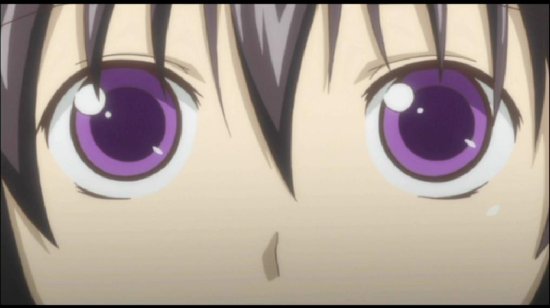
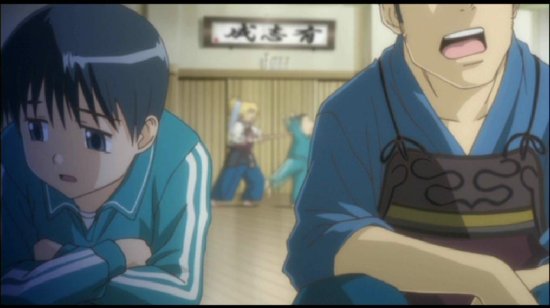
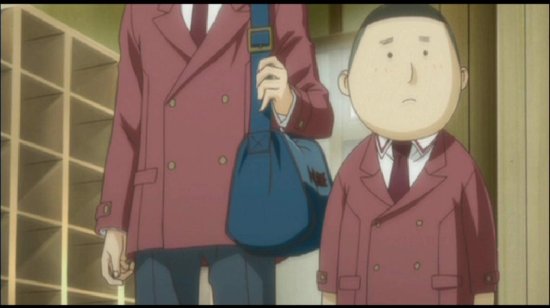

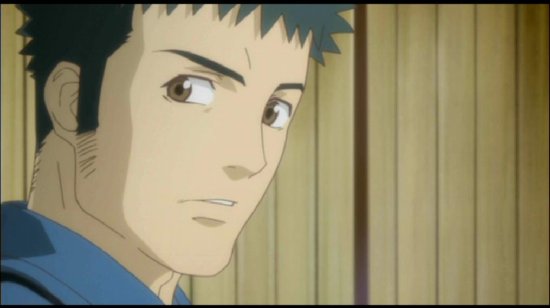
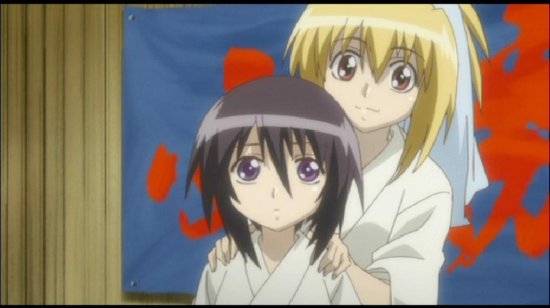
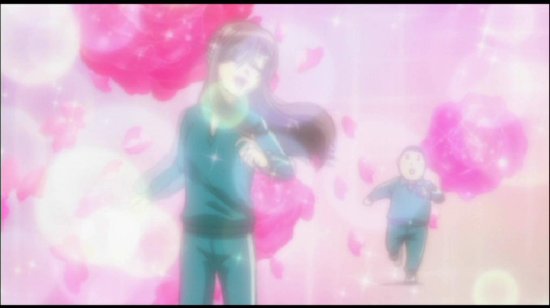
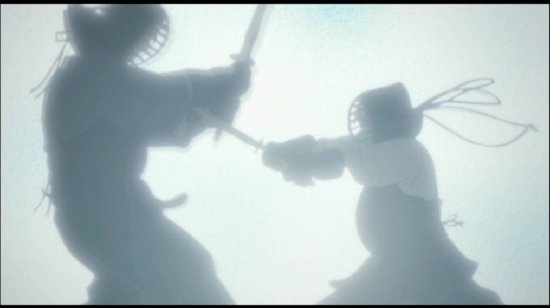
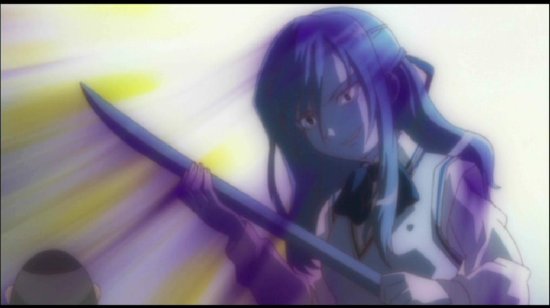
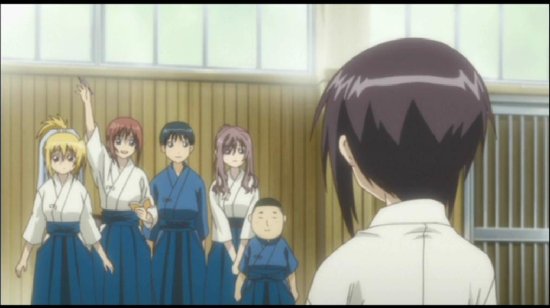

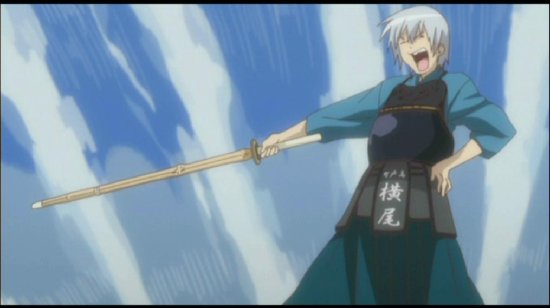
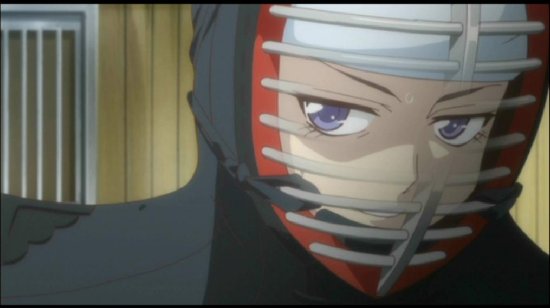
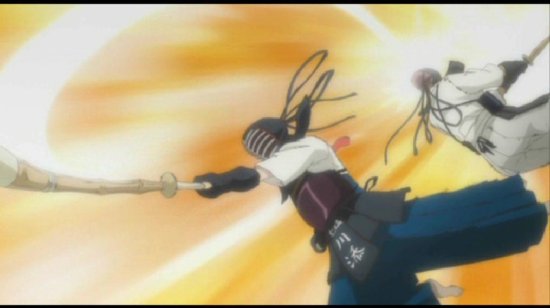
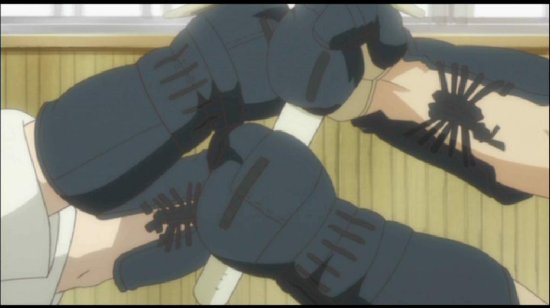
Your Opinions and Comments
Be the first to post a comment!